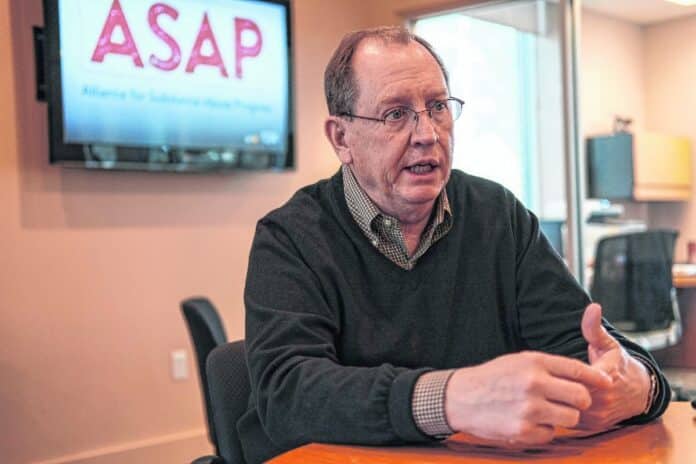
Alliance for Substance Abuse Progress leaders are hoping to address a significant gap in Bartholomew County’s ability to help people overcome substance use disorder –- a gap in available recovery housing.
ASAP Executive Director Doug Leonard said he is hopeful that four to six recovery residences will be operating in Bartholomew County by the end of the year, as ASAP continues to expand its reach after opening its Hub at the Doug Otto Center, 1531 13th St., nearly five months ago.
The Hub is a 2,000-square-foot recovery resource center for individuals, families and friends who are impacted by substance abuse disorder.
“There are still some gaps that exist (in the community). One that is most acute is housing,” Leonard said. “This is called recovery housing or sober housing. It’s for people that are going through treatment and need a safe place to go through their recovery. They’re often homes that are in the community and they house eight to 10 men or women.”
[sc:text-divider text-divider-title=”Story continues below gallery” ]
“We have no recovery homes now, and I think we need several,” he said.
Currently, the closest recovery housing for Bartholomew County women is in Monroe County, and the closest recovery housing for men is in Jennings County, said ASAP Hub Director Nathan Walsh.
ASAP began testing a pilot program on Monday to transport people to treatment and recovery programs, Leonard said. By Wednesday afternoon, ASAP had used a sedan it rented to take people out of town to residential treatment programs.
“We do not have any recovery housing options in Bartholomew County yet for them to live here, so they’re in the county where they are,” Walsh said. “So we are transporting them to the recovery house, but then, if they need to show up for court, we make sure that they can get back here to go to Judge (Kelly) Benjamin’s (drug recovery) court.”
However, Bartholomew County could start seeing recovery housing options become available in the coming weeks. The Chain Breaker House, a former church parsonage-turned-recovery residence at 1218 California St., is expected to open Feb. 1, and the Fresh Start Recover Center, an addiction treatment facility for expectant women and mothers located at 703 Washington St., is expected to follow suit later this year.
Rick Colglazier, Chain Breaker project leader, said he and others involved in the project are in the process of putting the final touches on the house, but still need to install a set of fire doors and pass a city inspection. The fire doors have been ordered and are expected to arrive around Jan. 15, Colglazier said.
“Our work is cut out for us, but we’re really anxious to put this thing in full motion,” Colglazier said.
Leonard said there are several operating models for recovery housing — including faith-based programs and other types of curriculum — and he hopes to see a variety of options for those needing help in Bartholomew County.
“We’d be thrilled to see a variety of different models here,” Leonard said. “…We embrace all of them because each one can serve somebody who might not do well in the others.”
Besides recovery housing, another priority for ASAP this year includes helping local businesses develop a workforce strategy to assist employees or applicants who are struggling with substance abuse disorder, Leonard said.
ASAP, along with the Columbus Area Chamber of Commerce and other organizations, plan to sponsor a forum for local businesses later this year, he said.
“There are models now to give them a pathway to work,” Leonard said. “…That is to bring information to employers if they are struggling with this issue and would like to have some approaches that are easier, especially in this high-employment time. It’s difficult because employers are all scrambling to hire employees and employees failing a drug test is a real deterrent to them being able to have full staff.”
Overall, Leonard said he and his team are looking forward this year to continuing to serve the recovery community and people in need of treatment.
“(The Hub) has turned out to be not only just a physical magnet, but a virtual magnet for other organizations to work with us,” Leonard said. “We’re finding a lot of new ways and I think we’re knitting together a better safety net than what existed before we were here.”
[sc:pullout-title pullout-title=”What is ASAP” ][sc:pullout-text-begin]
The Alliance for Substance Abuse Progress began when in fall 2016, when Columbus Mayor Jim Lienhoop, Bartholomew County Commissioner Carl Lienhoop and Columbus Regional Hospital Jim Bickel agreed to work collaboratively to develop a community-wide response to the opioid epidemic. In early 2017, executive lead Jeff Jones was recruited and volunteered his services.
The city of Columbus donated office space at city hall and the initiative was named Alliance for Substance Abuse in Bartholomew County. ASAP was introduced to the community at a meeting at The Commons in April 2017.
Jones has since stepped aside after the organizational work was completed in 2019 and the ASAP Hub opened. Doug Leonard is the new executive director, leading the organization from offices in The Hub.
[sc:pullout-text-end][sc:pullout-title pullout-title=”Where to find the Hub” ][sc:pullout-text-begin]
The ASAP Hub is located in the Doug Otto Center at 1531 13th St.
[sc:pullout-text-end][sc:pullout-title pullout-title=”Where to learn more” ][sc:pullout-text-begin]
Visit asapbc.org/asap-hub/ or call 812-418-8705 or for more information.
[sc:pullout-text-end]




